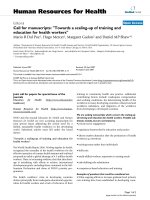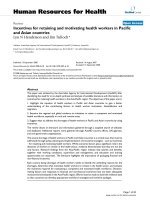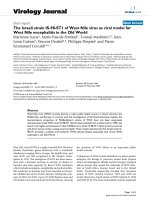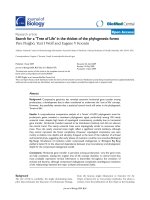Báo cáo sinh học: "Procedures for listing loci and alleles of ruminants: 1991 proposals" pot
Bạn đang xem bản rút gọn của tài liệu. Xem và tải ngay bản đầy đủ của tài liệu tại đây (332.15 KB, 7 trang )
Letter
to
the
Editor
Procedures
for
listing
loci
and
alleles
of
ruminants:
1991
proposals
E
Andresen
T
Broad
L
Di
Stasio
CHS
Dolling
D Hill
K
Huston
B
Larsen
JJ
Lauvergne
H
Levéziel
9
X
Malher
P
Millar
AL
Rae
C
Renieri
EM
Tucker
1
!
Division
of
Animal
Genetics,
Department
of
Animal
Science
and
Health,
Biilowsvej
13,
1870
Frederiksberg
C,
Denmark;
2
DSIR
Grassland,
Palmerston
North,
New
Zealand ;
3
Dipartimento
di
Scienxe
Zootechnice,
Via
Genova,
6,
10126
Turin,
Italy;
4
Box
74,
Mc
Laren
Vale,
SA
5171,
Australia;
!
University
of
Otago,
Department
of
Biochemistry,
Box
56,
Dunedin,
New
Zealand;
6
1689
Arthur
Drive,
Wooster,
OH
!,!,
691,
USA;
!
National
Institute
of
Animal
Science,
Department
of
Animal
Physiology
and
Biochemistry,
PO
Box
39,
8830
Tjele,
Denmark;
8
Laboratoire
de
Génétique
Factorielle,
Département
de
Génétique
Animale
de
l’INRA,
CRJ,
78
352
Jouy-en-Josas,
C!dex;
!
Laboratoire
de
Genetique
Biochimique,
Department
de
Génétique
Animale
de
l’INRA,
CRJ,
78
352
Jouy-en-Josas,
Cedex;
10
Ecole
Nationale
V6t6rinaire
de
Nantes,
D6partement
des
Productions
Animales,
BP
527,
44
026
Nantes
C6dex,
France;
11
Britbred
Ltd,
12A
Riselaw
Crescent,
Edinburgh,
EHIO
6HL,
UK;
12
16,
Wallace
Place,
Palmerston
North,
New
Zealand;
13
Istituto
di
Produzioni
Animali,
Via
San
Constanzo
4,
06100
Perugia,
Italy;
14
AFRC,
Institute
of
Physiology
and
Genetics
Research,
Babraham,
Cambridge
CB2
4AT,
UK
(Received
27
February
1992;
accepted
31
March
1992)
Summary -
The
following
procedures
for
listing
loci
in
ruminants
were
proposed
at
the
1991
1st
Workshop
on
Genetic
Nomenclature
of
Farm
Ruminants
organised
by
COGNOSAG
(Committee
on
Genetic
Nomenclature
of
Sheep
and
Goats):
identification
of
locus,
genomic
location,
gene
effect
classification
(24
entries),
summary
of
alleles
and,
for
each
allele,
after
identification,
phenotypic
effect,
inheritance
and
breeds
implied.
This
*
Correspondence
and
reprints
set
of
procedures
is
intended
for
the
first
edition
of
the
MIS,
MIG
and
MIC
catalogues
(mendelian
inheritance
in
sheep,
goats
and
cattle,
respectively)
and
is
a
basis
for
future
data
banking.
ruminants
/
loci
/
listing
procedures
/
nomenclature
R.ésumé -
Procédures
de
listage
des
loci
et
allèles
des
ruminants
1991.
Au
cours
du
premier
Atelier
de
Nomenclature
Génétique
des
Ruminants
de
Ferme
organisé
par
le
COGOVICA
(Comité
de
Nomenclature
Génétique
des
Ovins
et
Caprins)
en
1991,
les
procédures
suivantes
de
listage
des
loci
chez
les
Ruminants
ont
été
proposées:
identification
du
locus,
localisation
sur
le
génome,
effet
du
gène
(24
entrées),
tableau
des
allèles
et,
pour
chaque
allèle,
outre
l’identification,
l’effet
phénotypique,
l’hérédité
et
les
races
concernées.
Conçue
pour
être
utilisée
dans
la
première
édition
des
catalogues
MIS,
MIG
et
MIC
(Mendelian
Inheritance
in
Sheep,
Goats
and
Cattle
resp),
cette
grille
peut
servir
de
base
pour
une
future
banque
de
données.
ruminants
/
loci
/
procédures
de
listage
/
nomenclature
INTRODUCTION
The
definition
of
guidelines
for
gene
nomenclature
of
sheep
and
goats
was
prepared
during
COGNOSAG
Workshops
(Committee
on
Genetic
Nomenclature
of
Sheep
and
Goats)
in
1987
and
1989
(Alexieva
et
al,
1989a,
1990).
At
the
1991
Workshop,
entitled
First
Workshop
on
Genetic
Nomenclature
of
Farm
Ruminants,
these
guidelines
were
reviewed
so
that
they
would
be
suitable
for
all
ruminants
(Andresen
et
al,
1991).
Besides
these
guidelines
COGNOSAG
started
to
elaborate the
general
procedure
of
listing
loci
and
alleles
of
sheep
and
goats
during
the
1987
Workshop
(Alexieva
et
al,
1989b).
This
document
was
revised
almost
without
change
during
the
Workshop
at
Eugene
(Oregon)
in
1989,
and,
at
the
above-mentioned
1991
Workshop,
these
procedures
were
again
reviewed
and
are
given
in
the
present
article.
The
purpose
is
to
make
them
suitable
for
all
ruminants
in
order
to
prepare
a
first
edition
of
MIS,
MIG
and
MIC
catalogues
(mendelian
inheritance
in
sheep,
goats
and
cattle
respectively)
and
also
to
be
used
in
future
data
banking.
OBJECTIVES
The
objectives
are
to
use
the
guidelines
for
gene
nomenclature
elaborated
during
the
above-quoted
1991
Workshop
(Andresen
et
al,
1991)
to
produce
a
list
of
loci
and
alleles
for
cattle,
sheep
and
goats,
and
to
assess
the
contribution
made
by
each
reference
to
knowledge
of
the
inheritance
of
the
allele.
The
list
and
assessment
are
such
that
they
can
be
fully
checked
by
other
workers,
and
can
be
added
to
or
amended
as
necessary.
CATEGORIES
OF
LOCI
AND
HEADINGS
Within
each
of
the
species -
cattle,
sheep
and
goats -
loci
are
classified
into
4
categories,
namely:
1.
Coat
colour
2.
Visible
traits
other
than
coat
colour
3.
Blood,
milk
and
other
body
fluids
4.
Other
genetic
systems
( eg
molecular
markers)
Loci
and
alleles
are
listed
within
each
of
the
above
categories.
The
information
available
on
each
locus
and
on
each
allele
should
be
given
under
the
following
basic
set
of
headings:
Locus
Name
Symbol
Other
names
Genomic
location
(with
references
and
status)
Gene
effect
classification
Summary
of
alleles
(name,
symbol,
status,
references)
Comments
on
the
locus
References
for
the
locus
Allele
Name
Symbol
Phenotypic
effect
of
allele
Inheritance
Status
Breeds
Comments
on
the
allele
References
for
the
allele
Then,
as
an
option,
at
the
end
of
the
listing
of
all
loci
and
alleles
in
a
category:
Bibliography.
LOCUS
DESCRIPTION
(DETAILS)
Name,
symbol,
other
names
Names
and
symbols
are
defined
as
set
out
in
the
COGNOSAG
Guidelines
for
Gene
Nomenclature
in
Ruminants
1991
(Andresen
et
al,
1991).
The
&dquo;other
names&dquo;
for
loci
include
those
which
have
been
used
in
the
literature
other
than
the
names
designated
by
COGNOSAG.
Geographic
terms
are
used
to
describe
loci
or
alleles
found
in
different
parts
of
the
world
if:
-
alleles
with
similar
effects
have
been
identified
in
different
regions;
-
tests
for
allelism
have
not
been
carried
out;
or
-
additional
description
is
needed
to
prevent
confusion
in
the
term
used
to
designate
locus
or
allele.
The
loci
are
considered
as
being
separate
until
tests
for
allelism
have
been
carried
out.
Genomic
location
This
will
be
specified
by
selecting
one
of
the
following
descriptors:
i)
undefined,
where
the
genomic
location
has
not
been
reported;
ii)
sex
chromosomes
or
autosome,
when
there
is
evidence
implicating
either
the
X/Y
chromosomes
or
the
autosomes
but
insufficient
evidence
to
go
beyond
this;
iii)
the
chromosome
number,
arm
or
region,
as
defined
by
ISCNDA
1989
rules
(1990)
and/or
earlier
reports
of
the
Committee
for
Standardisation
of
the
Karyo-
types
of
Domestic
Animals
(Reading
Conference,
1980;
Long,
1985).
If
only
chro-
mosome
number
but
no
further
information
on
the
regional
localisation
of
a
locus
is
known,
this
will
be
indicated
as
eg
&dquo;Chr
7&dquo;
or
&dquo;Chr
8&dquo;.
Designating
chromo-
some
arms
as
either
&dquo;p&dquo;
or
&dquo;q&dquo;
will
only
be
appropriate
for
the
sheep
autosomes,
chromosome
numbers
1-3,
the
cattle
X-chromosome
and
the
Y-chromosome
in
all
ruminants;
iv)
the
syntenic
group
will
be
designated
by
the
symbol
&dquo;U&dquo;
followed
by
an
Arabic
number,
eg
U1, U2,
etc
Such
designations
will
be
most
frequently
made
from
studies
involving
somatic
cell
hybrids
in
which
the
identification
of
ruminants
chromosomes
retained
by
the
hybrid
cells
has
not
been
reported;
v)
the
linkage
group
will
be
designated
by
the
symbol
&dquo;LG&dquo;
followed
by
an
Arabic
number,
eg LG1,
LG2,
etc ;
or,
vi)
mitochondrial,
where
it
is
known
that
the
locus
is
not
located
on
the
nuclear
genome,
but
is
present
on
the
mitochondrial
genome.
In
most
cases,
it
will
be
sufficient
to
select
only
one
of
those
descriptors.
However,
there
may
be
instances
in
which
it
is
informative
to
specify
2
such
descriptors,
eg
linkage
groups,
as
well
as
the
chromosome
number.
Reference:
a
short
reference
comprising
the
name(s)
of
the
authors
and
year
will
be
given
to
support
the
genomic
location of
each
locus.
Status:
P
or
C.
The
&dquo;P&dquo;
is
to
be
allocated
when
there
is
only
a
single
report
of
the
location
of
a
locus
indicating
that
its
location
is
&dquo;provisional&dquo;.
The
&dquo;C&dquo;
will
be
awarded
when
the
location
of
a
locus
has
been
&dquo;confirmed&dquo;.
Gene
effect
classification
Each
locus
is
classified
into
one
or
more
of
the
following
classes:
1.
Coat
colour
2.
Skin,
fibres,
hooves
and
horns
and
function
3.
Skeletal
system
(including
legs
and
tail)
and
function
(including
locomotion)
4.
Appendages
(including
outer
ears
and
wattles)
5.
Nervous
system
(including
brain,
inner
ear
and
eye)
and
function
6.
Endocrine
system
(including
dwarfism
and
obesity)
and
function
7.
Reproductive
system
(including
fertility,
gametes,
zygotes,
embryos
and
fetuses)
and
function
8.
Circulatory
system
and
function
9.
Digestive
system
(including
metabolism)
and
function
10.
Muscle
and
function
11.
Urinary
system
and
function
12.
Respiratory
system
and
function
13.
Mammary
glands
and
lactation
14.
Lethal,
sublethal
and
subvital
factors
15.
Plasma
enzymes
16.
Plasma
proteins
other
than
enzymes
17.
Erythrocyte
enzymes
18.
Erythrocyte
proteins
and
transport
systems
other
than
enzymes
19.
Erythrocyte
antigens
20.
Lymphocyte
antigens
21.
Milk
proteins
22.
Leucocyte
enzymes
23.
Leucocyte
proteins
other
than
enzymes
24.
Resistance
to
assault
Disease
Toxins
Other
25.
DNA
sequences
Summary
of alleles
(table)
Name
and
symbol:
the
names
and
symbol
are
given
as
set
out
in
the
COGNOSAG
Guidelines
for
Gene
Nomenclature
in
Ruminants
1991
(Andresen
et
al,
1991).
The
alleles
are
listed
in
order
of
dominance,
where
known,
the
dominant
allele
being
at
the
top.
Status:
the
evidence
presented
for
each
allele
is
assessed
as
follows,
unless
otherwise
indicated
in
the
introduction
to
a
category
listing:
- the
evidence
is
such
that
the
existence
of
the
allele
as
being
the
cause
of
the
effect
is
established
beyond
reasonable
doubt.
Segregation
data
which
demonstrate
this
must
be
given.
Evidence
for
the
allele
is
unequivocal;
- the
evidence
is
such
that
the
allele
is
most
probably
the
cause
of
the
effect,
but
the
possibility
of
other
causes
has
not
been
reasonably
excluded.
Reports
in
this
category
would
include
those
with
extensive
population
studies
or
those
with
segregation
data
consistent
with
the
existence
of
the
allele,
but
for
which
the
evidence
is
not
unequivocal.
-
the
essence
of
an
allele
is
postulated
to
explain
the
phenotype
described:
little
or
no
evidence
is
presented
by
the
author.
References
(in
the
table):
the
references
for
alleles
are
presented
with
the
name
of
the
author
and
year.
Comments
on
the
locus
Comments
may
include
historical
definition
of
the
effects
of
the
locus
or
of
the
breeds
which
express
the
locus,
and
descriptions
of
cattle,
sheep
and
goats
with
different
genetic
backgrounds.
The
nature
of
the
evidence
for
the
existence
of
the
locus
may
be
discussed.
Homology
of
the
locus
with
loci
in
other
species,
where
known,
is
indicated.
References
for
the
locus
References
for
the
locus
may
be
listed
here
or
in
a
bibliography
at
the
end
of
the
category.
They
are
given
in
alphabetical
order
of
the
name
of
the
first
author,
and
are
not
numbered.
All
references
for
any
category
should
be
either
in
this
format:
Adalsteinsson
S,
Basrur
PK
(1984)
Inheritance
of
spina
bifida
in
Icelandic
lambs.
J
Hered
75,
378-382
or
in
this
format:
Adalsteinsson
S,
Basrur
PK
(1984)
J Hered
75,
378-382
ALLELE
DESCRIPTION
(DETAILS)
Phenotypic
effect
A
brief
description
is
given
of
the
effects
of
the
allele.
The
effects
are
those
observed
in
the
genetic
background
of
the
breed
or
strain
of
cattle,
sheep
or
goats
with
which
the
authors
worked,
or
on
the
wild
type.
The
effects
of
the
allele
are
described
from
the
phenotypes
of
animals
homozygous
for
the
allele
in
question
whenever
possible.
Inheritance
Comments
are
made
on
the
pattern
of
inheritance -
possibly
including
some
of
the
following
terms:
-
pleiotropy,
polygenic
(quantitative),
genetic
background,
epistasis;
-
incomplete
penetrance,
variable
expressivity,
threshold
character;
-
dominant,
co-dominant,
recessive.
Status:
an
assessment
of
the
evidence
presented
for
each
allele
is
made
as
described
above.
Breeds
The
breeds
mentioned
in
the
references
quoted
for
each
allele
are
given.
As
a
precaution
against
unwarranted
extrapolation
or
inference,
breeds
not
quoted
in
references
are
not
listed.
Comments
Comments
may
include
the
historical
definition
of
the
effects
of
the
allele
in
the
breeds
which
carry
the
allele,
and
descriptions
of
cattle,
sheep
and
goats
with
different
genetic
background.
The
nature
of
the
evidence
for
the
existence
of
the
allele
may
be
discussed.
References
for
the
allele
References
for
the
allele
may
be
listed
here
or
in
a
bibliography
at
the
end
of
the
category.
They
should
all
be
in
one
of
the
forms
exemplified
above
(see
References
for
the
locus).
REFERENCES
Alexieva
SA,
Aliev
G,
Bourzat
D,
Denis
B,
Dolling
CHS,
Lauvergne
JJ,
Lundie
RS,
Millar
P,
Rachovski
ML,
Rae
AL,
Renieri
C,
Sponenberg
DP,
Tucker
EM
(1990)
Gene
nomenclature
in
sheep
and
goats,
1989,
In:
Loci for
Coat
Colour
in
Sheep
and
Coats
(JJ
Lauvergne,
ed)
COGNOSAG,
Clamart
Alexieva
SA,
Denis
B,
Dolling
CHS,
Lauvergne
JJ,
Lundie
RS,
Millar
P,
Rae
AL,
Renieri
C,
Sponenberg
DP,
Tucker
EM
(1989)
Gene
nomenclature
in
sheep
and
goats
1987.
In:
Proc
COGNOSAG
Workshop
1987 (JJ
Lauvergne,
ed)
Bureau
Ressources
G6n6tiques,
Paris,
17-21
Alexieva
SA,
Denis
B,
Dolling
CHS,
Lauvergne
JJ,
Lundie
RS,
Millar
P,
Rae
AL,
Renieri
C,
Sponenberg
DP,
Tucker
EM
(1989b)
General
procedures
for
listing
loci
and
alleles
of
sheep
and
goats
1987.
In:
Proc
COGNOSAG
Workshop
1987
(JJ
Lauvergne,
ed)
Bureau
Ressources
G6n6tiques,
Paris,
23-32
Andresen
E,
Broad
T,
Di
Stasio
L,
Dolling
CHS,
Hill
D,
Huston
K,
Larsen
B,
Lauvergne
JJ,
Lev6ziel
H,
Malher
X,
Millar
P,
Rae
AL,
Renieri
C,
Tucker
EM
(1991)
Guidelines
for
gene
nomenclature
in
ruminants
1991.
Genet
Sel
Evol
23,
461-466
ISAG
Nomenclature
Standardisation
Workshop
(1985)
Anim
Blood
Groups
Biochem
Genet
16,
249-252
ISCNDA
(1989,
1990)
International
System
for
Cytogenetic
Nomenclature
of
Do-
mestic
Animals
(D
Di
Bernardino,
H
Hayes,
R
Fries,
S
Long,
eds)
Cytogenet
Cell
Genet
53,
65-79
Long
S
(1985)
Standard
nomenclature
for
the
G-band
karyotype
of
the
domestic
sheep
(Ovis
aries).
Hereditas
103,
165-170
Reading
Conference
(1980)
Proc
1st
Int
Conf
Standard
Banded
Karyotypes
Domest
Anim,
Reading,
England,
1976
(EC
Ford,
DL
Pollock,
I
Gustavsson,
eds)
Hereditas
92,
145-162









